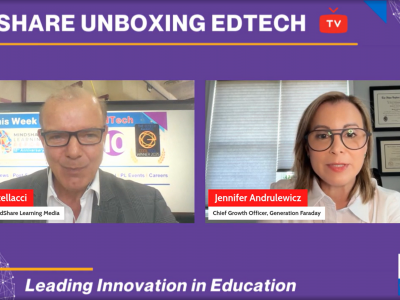By Tim Gard, TDSB Educator & MSL Report Contributing Writer
I remember the first time we delved into the realm of mobile learning in a big way at our school. We had 24 Dell Netbooks, loaded with the latest software, with eager students ready to launch into the next wave of learning away from the typical school context that tethered them to a fixed place, at a fixed time with a few machines. The result was nothing short of frustrating. With our single point of access we were able to get only a fraction of the netbooks logged on to the network, and then with limited connectivity. In spite of the frustrations, the obstacles that we were faced with and the large amount of time required to bring our teachers up to speed on mobile computing theory and pedagogy, we saw what mobile learning could do for us. In short, we were excited and primed for more, and we were willing to take the risk. We’ve come a relatively long way from that scenario in 2010, but there is still a long way to go.
Let me give you three things that you should think about with regards to mobile learning and what needs to happen in order for it to flourish. Of course, you could add your own ideas – this is not about the ‘entire picture’ but just a small snapshot of some things to consider at the school level before you delve more deeply – if you haven’t already – into the realm of mobile computing.
Leadership
I don’t think there’s anything that I write about in teaching and learning with technology that doesn’t include something about leadership. This is the case because good leadership provides vision, support and creates an infrastructure that encourages innovation, and builds trust. This is the essence of collaborative teamwork and collaborative teamwork is powerful, unifying and satisfying. Team successes lead to more team successes – it’s a wonderful circle when it happens. This kind of team work is developed more effectively in smaller schools where teachers have a strong sense of community. And community just doesn’t happen.
There are so many elements that are part of a collaborative work environment where team members work together toward a common goal. This is something that needs to be worked at all of the time, not just some of the time. From my observation when schools are unified in purpose then the purpose becomes something that is workable, and the team then becomes successful together. No more emphasis on the ‘guru’ mentality that still exists today. All stakeholders are important and no one person concocts the narrative on how this will all play out in the end. Good leaders realize this and foster this mentality and philosophy.
Administrators who are willing to move their entire school into an environment that embraces mobile learning need to do so carefully, and logistically. It is worth the time to get EVERY stakeholder (teachers, administrators, caretakers, parents) involved in the discussion about how mobile learning will be implemented, what the projected issues will be and how teachers can prepare themselves for technology that can be used in any space in the school. If you’ve created a unified team you’re most of the way there. I love to have brainstorming sessions about new ideas and technologies where teachers can come and ask any question about a ‘new’ technology. Every person in your school who is involved in this brainstorming session will help to avoid the blind spots that we often miss when this type of work is done in small groups where all members have already assented to the general idea.
Resource: Patrick Lencioni: The Advantage – Why Organizational Health Trumps Everything Else in Business; The Five Dysfunctions of a Team
Hardware, Hardware, Hardware
If you have read anything about the massive iPad deployment in the LA County Unified School District then you’ll realize that mobile capable devices are needed in order to take advantage of a mobile infrastructure however deploying huge amounts of hardware creates many other problems. You need an infrastructure to support a mobile learning environment. How many devices can you connect to your school’s wireless network without serious degradation? If you roll out mobile capable devices and there are issues connecting these devices to the wireless network then you’re going to create frustration with your teachers. Time wasted in classrooms takes a serious toll on teacher morale around the integration of technology.
I can’t help but wonder how we’re going to actually use mobile technology effectively in classrooms when too few classrooms have mobile capable hardware. It is of course an issue of cost. Who’s going to spend the millions of dollars needed to buy, maintain and create a sustainable infrastructure to make this all happen? Vendors can make this stuff for free and there’s only so many pilots that can happen. If you’re like my school you’ve sought out other revenue streams. This however creates issues around equity. I worked at an inner-city school where there was one member of the school council and fund raising was a pipe dream at best. How do we support all students and teachers?
We know that technology needs to be used and harnessed more effectively in classrooms, and since Inquiry-based learning becomes more of a larger focus in teaching and learning the need for more technology is imperative. Everyone’s talking about technology as one of the key enhancers to teaching and learning. Buzzwords aside, we need to come up with a solid plan to roll out hardware to districts. Obviously, one of the key lynchpins for having this happen is a cogent BYOD philosophy. Allow students to bring their own devices to school and allow these students to access district-approved learning materials via a cloud-based learning platform, among other things. This is not as easy as it sounds. There are still barriers to overcome. I’m not going to get into the details here, and if you’re a CTO or CIO you are more than aware of the issues.
I would however like to suggest that more money needs to be spent on mobile capable devices in K-6 environments than in the older panels. Why? Once BYOD becomes more viable in a district where concerns of access, content and security are addressed it is not realistic in the younger age groups for a number of obvious reasons. Further, deploying mobile technology in the earlier grades, and spending money on encouraging sound pedagogical practices for teachers in the elementary grades, will pay dividends down the road. Students and teachers who are trained in the use of mobile technology, who become less focused on the technology per se, will be more likely in later years to use the mobile technology responsibly. Start with the foundation and build out of that foundation. Give the hardware needed to the elementary schools and provide the necessary training at the school-level to teachers and you will then see a much more enhanced teaching and learning environment in middle and high school. This doesn’t mean that the infrastructure for the district is compromised by this rollout philosophy; it does mean however that the actual devices used to connect to the infrastructure are more readily available for elementary aged students and the requisite teachers.
Resources: K12 Blueprint for Personalized Learning (see resources section): Microsoft Education BYOD Guide
Who Needs Technical Support?
There is not one single teacher that I know who has deployed and attempted to integrate mobile technology in the classroom that has not required some technical support at some level. I suppose this also applies to technology in general however mobile technology seems to have become even more of an issue if your involved in deploying and managing tablets. Apple’s ubiquitous iPad can be managed effectively with the right software however learning how to use the software is something that teachers have to figure out on their own most of the time. Windows 8 tablets? No support in our district. Android tablets? Again, tough to rollout unless you have some serious experience and the patience required to make it work. Teachers want to teach. They don’t want to spend time attempting to spend huge amounts of time managing devices in a classroom setting without some serious technical support.
Do not rollout mobile technology in your school or district without giving serious thought to how teachers are going to manage them. And do not assume that teachers will spend the time to learn how to manage the technology is they don’t have at least some support. This kind of support is likely going to be more effective if it is school-based and not district-based. True, this is expensive however if districts are serious about implementing mobile technology effectively they need to be serious about providing support for the teaching cadre at each school. Perhaps providing a half-time, 2-year position for teachers who are the teacher-leaders at the school level in the area of teaching and learning with technology. This would over time create enough capacity so that in the future teachers will be able to problem solve on their own.
Further, serious technical issues need to be resolved quickly. If teachers have to wait to have their technical issues resolved – anything to do with hardware or software failure – they will be less inclined to sue the technology in the future. Enough said.
Pedagogy, Pedagogy, Pedagogy
Reading about the issues that surround the implementation of mobile computing in a school usually includes a point about the lack of training for teachers. You cannot create a mobile technology solution that does not provide ongoing, rigorous, workable, hands-on training that teachers can emulate in their particular classrooms. It just won’t be successful. And further to this point I would like to add that huge group sessions where everyone goes to listen to a ‘talking-head’ does not work either. As to my last point in the section above, the training has to be ‘on-site’ and recursive. The focus should be on creating teacher-leaders at each individual school. These ‘go-to’ people should be supported by the true experts in integrating technology across the curriculum at the district-level (instructional leaders) who can provide these teacher-leaders with the support they need in smaller settings. Support begets support.
I can’t possibly cover every detail of how to provide an environment where teachers can be supported in their use of mobile technology in the classroom in a pedagogically sound way. There a huge number of resources that you can access to help you understand the need in this area, and also provide you with some tried and true examples of how you might use said technology effectively in your classroom. There is however a very small number of teachers who have mastered integration of technology across the curriculum. This is true for a number of reasons.
Firstly, it’s a relatively new area. Time will add more mature and seasoned teacher professionals who can give sage advice to integrating technology across the curriculum in potent ways. We do need to however encourage this development. Districts need to acknowledge, fund and prepare vision statements for this to happen. Grassroots development will happen but it will happen much more quickly if leadership and needed resources are made available
Secondly, technology needs to be seen as an enhancer. Teachers who use technology are not ‘techies’ but teachers who want to use technology to enhance their classroom program. We need to stop focusing on making the ‘techies’ some special class of teacher. All teachers can acquire enough knowledge to solve technical problems, become innovative using technology and to take some risks in order to explore the unknown. If you have a ‘tech-guru’ at your school, slowly release them from this responsibility by encouraging others to take steps to integrate technology into the classroom and stop focusing on the technology – make it about teaching with the technology! Everyone in this day and age should be using technology, not just the individual who feels it’s his or her ‘claim to fame’.
Create a collaborative environment at your school where teachers can ‘pop in and out’ of classrooms to see mobile learning in action, and encourage safe learning by encouraging teachers to ask the question they’re afraid to ask. Ensure that the leadership at the school is informed, enthusiastic, encourages risk-taking and make every effort to create a learning environment that is team-based and collaborative. This is true of any environment for teaching and learning however mobile learning creates a completely different set of teaching and learning environments and leadership that supports this shift will help to encourage the transitions in teaching and learning that need to occur.
I hope these ideas help you to think more broadly about deploying and sustaining a mobile learning environment. It doesn’t come without problems, but the risks are worth it, especially if it helps to create an engaging learning environment where students explore, inquire, problem-solve and collaborate creatively. Our future needs them. And mobile learning can certainly help school environments become more ‘student centered’ and powerful centres of change and discovery for these skills to develop.










